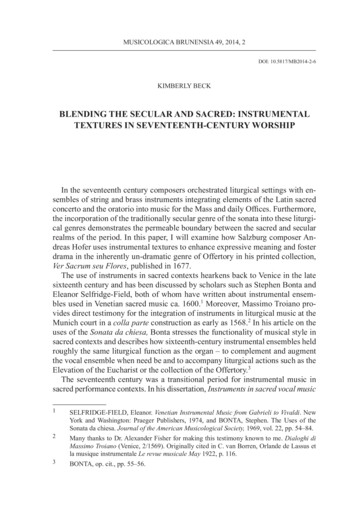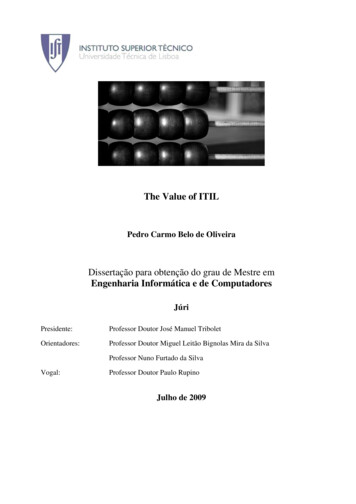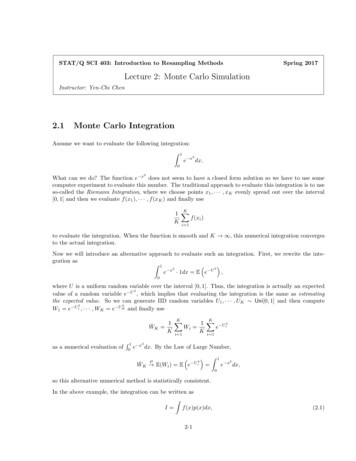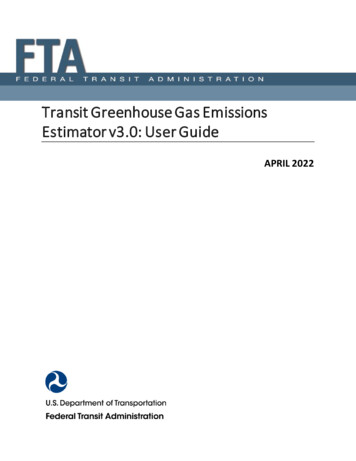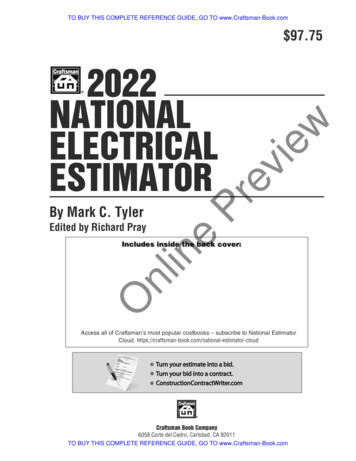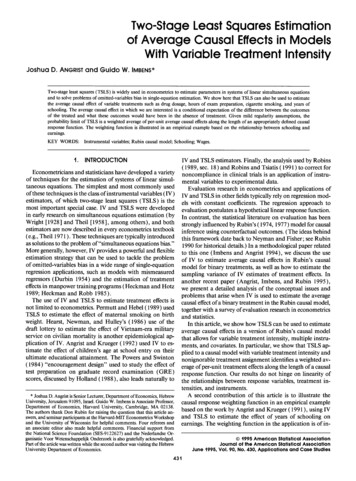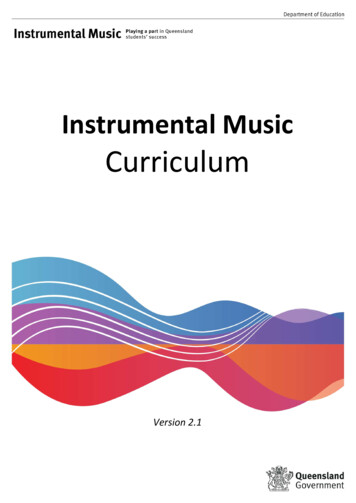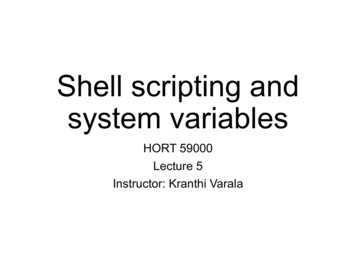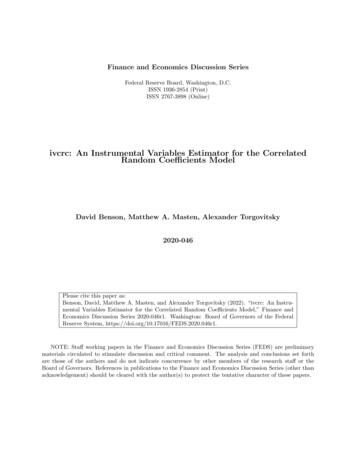
Transcription
Finance and Economics Discussion SeriesFederal Reserve Board, Washington, D.C.ISSN 1936-2854 (Print)ISSN 2767-3898 (Online)ivcrc: An Instrumental Variables Estimator for the CorrelatedRandom Coefficients ModelDavid Benson, Matthew A. Masten, Alexander Torgovitsky2020-046Please cite this paper as:Benson, David, Matthew A. Masten, and Alexander Torgovitsky (2022). “ivcrc: An Instrumental Variables Estimator for the Correlated Random Coefficients Model,” Finance andEconomics Discussion Series 2020-046r1. Washington: Board of Governors of the FederalReserve System, https://doi.org/10.17016/FEDS.2020.046r1.NOTE: Staff working papers in the Finance and Economics Discussion Series (FEDS) are preliminarymaterials circulated to stimulate discussion and critical comment. The analysis and conclusions set forthare those of the authors and do not indicate concurrence by other members of the research staff or theBoard of Governors. References in publications to the Finance and Economics Discussion Series (other thanacknowledgement) should be cleared with the author(s) to protect the tentative character of these papers.
ivcrc: An Instrumental Variables Estimator forthe Correlated Random Coefficients ModelDavid Benson Matthew A. Masten†Alexander Torgovitsky‡March 3 2022AbstractWe discuss the ivcrc module, which implements an instrumental variables (IV) estimator forthe linear correlated random coefficients (CRC) model. The CRC model is a natural generalization of the standard linear IV model that allows for endogenous, multivalued treatmentsand unobserved heterogeneity in treatment effects. The estimator implemented by ivcrc usesrecent semiparametric identification results that allow for flexible functional forms and permitinstruments that may be binary, discrete, or continuous. The ivcrc module also allows forthe estimation of varying coefficients regressions, which are closely related in structure to theproposed IV estimator. We illustrate use of ivcrc by estimating the returns to education inthe National Longitudinal Survey of Young Men.Keywords: ivregress, Instrumental Variables, Correlated Random Coefficients, HeterogeneousTreatment Effects, Varying Coefficient Models, Returns to Schooling Division of Research and Statistics, Federal Reserve Board of Governors. The analysis and conclusions set forthare those of the authors and do not indicate concurrence by other members of the research staff of the Federal ReserveSystem or of the Board of Governors.†Department of Economics, Duke University.‡Kenneth C. Griffin Department of Economics, University of Chicago. Research supported in part by NationalScience Foundation grant SES-1846832.1
1IntroductionIn this paper we describe the ivcrc module for Stata, which implements a linear instrumentalvariables (IV) estimator for the correlated random coefficients (CRC) model. The CRC modelrelaxes the constant effects assumption of the standard linear IV model by allowing for randomcoefficients, which capture unobserved heterogeneity in the causal effect of the endogenous variables,X, on the outcome variable, Y . Heckman and Vytlacil (1998) and Wooldridge (1997, 2003, 2008)showed that if there is no unobserved heterogeneity in the way the instrument, Z, affects theendogenous variables, X, then the usual linear IV estimator (e.g., ivregress) will estimate themean of the random coefficients. However, this assumption is uncomfortably asymmetric: treatmenteffects can be unobservably heterogeneous, but instrument effects cannot.Masten and Torgovitsky (2016) address this drawback by showing how to allow for heterogeneityin the relationship between Z and X. The identification arguments developed there allow for theinstrument to be binary, discrete, or continuous, and depend only on familiar, low-level assumptionsabout exclusion, exogeneity, and instrument relevance. The arguments also lead to a semiparametricestimator that does not suffer from the curse of dimensionality. In Section 2, we briefly review theidentification results and estimation approach developed in Masten and Torgovitsky (2014, 2016).The ivcrc module implements their proposed estimator.The structure of the estimator turns out to be quite similar to a common estimator for thevarying coefficient models (e.g., Fan and Zhang 2008; Park, Mammen, Lee, and Lee 2015). Wehave written ivcrc to include a standard estimator for these models as a special case. We brieflydescribe varying coefficient models in Section 3.In Section 4 we discuss syntax and options for the ivcrc module. In Section 5 we illustratethe module by estimating the return to schooling with a widely-used extract from the NationalLongitudinal Survey of Young Men. For further examples, see Gollin and Udry (2020), who usedthe ivcrc module to estimate agricultural production functions, Morales-Mosquera (2019), whoused it to estimate the effects of police infrastructure in Colombia, and Masten and Torgovitsky(2014), who used the estimator to revisit Chay and Greenstone’s (2005) analysis of the effect of airpollution on housing prices.22.1The Correlated Random Coefficients ModelModel and MotivationThe simplest form of the model estimated by ivcrc has the outcome equationY B0 B1 X,2(1)
where Y is an observed outcome, X is an observed explanatory variable, and both B0 and B1are unobserved random variables. The model is described as a random coefficients model due tothe treatment of B1 as an unobserved random variable. Economists have long been interested insuch models (Wald 1947; Hurwicz 1950; Rubin 1950; Becker and Chiswick 1966). To allow forendogeneity, X is permitted to be arbitrarily dependent with both B0 and B1 . This feature makesthe model one of correlated random coefficients.1It is helpful to compare (1) with the outcome equation for the textbook linear model:Y α βX U,(2)where α and β are fixed (deterministic) parameters, and U is an unobservable random variablewith mean zero. This model also allows for endogeneity by permitting X to be dependent with U .The distinction between U in (2) and B0 in (1) is not important, since one can view B0 as beingequal to α U . Rather, the important difference between (2) and (1) is that the coefficient on Xin (2), i.e. β, is deterministic, whereas the coefficient on X in (1), i.e. B1 , is a random variable.The interpretation is that in (2) the causal effect of X on Y is the same for all agents, whereasin (1) it is a random variable that can be dependent with X. This important difference allows forheterogeneous treatment effects and selection on the gain of the sort described in Heckman, Urzua,and Vytlacil (2006b). One can view (2) as a special case of (1) with a degenerate B1 .Textbook discussions of (2) show that β is identified if there exists an instrument Z such thatCov(U, Z) 0 and Cov(X, Z) 6 0. The corresponding IV estimator can be implemented in Statawith the ivregress command. However, if the data is in fact generated by (1), then this estimatorconverges to Cov(Y, Z)X(Z E(Z)) E B1 .Cov(X, Z)E[X(Z E(Z))](3)This quantity is difficult to interpret in general (Garen 1984; Wooldridge 1997; Heckman andVytlacil 1998). It is a weighted average of the causal effect of X on Y ; that is, a weighted averageof B1 . The weights, however, can be both positive and negative. It generally does not equal theunweighted average of B1 unless B1 is independent of (X, Z), which would rule out the type ofselection on the gain scenario described in Heckman et al. (2006b).A natural question is whether there are additional assumptions under which the IV estimatorprovided by ivregress would consistently estimate a parameter that is easier to interpret. Forexample, are there additional conditions under which this estimator converges to the average partialeffect, E[B1 ]? Heckman and Vytlacil (1998) and Wooldridge (1997, 2003, 2008) show that there are1This terminology seems to have been first used by Heckman and Vytlacil (1998). In earlier work, some authors,for example, Conway and Kniesner (1991), had used the adjective “correlated” to describe an unrestricted correlationstructure between the random coefficients on different explanatory variables. Our model also allows for this.3
indeed such conditions, namely, the assumption that the causal effect of Z on X is homogenous.While convenient, this type of homogeneity assumption is uncomfortably asymmetric. It enablesthe additional heterogeneity in equation (1) relative to equation (2) only by assuming away thesame type of heterogeneity in the analogous relationship between Z and X.22.2Identification and Estimation by Conditional Linear RegressionGiven these negative results, it is worthwhile to consider estimators other than ivregress. Theivcrc module provides such an estimator. This estimator is based on the following control functionargument, which is developed more formally in Masten and Torgovitsky (2016).3Suppose that there exists an observable variable R such that X (B0 , B1 ) R. The variable Ris a “control function” (or sometimes, and more loosely, a “control variable”) because it controlsfor the endogeneity in X. That is, while X is endogenous in the sense of being unconditionallydependent with (B0 , B1 ), it is exogenous after conditioning on the control function R. In practice,R is constructed from the instrument; we explain the derivation and construction of R in moredetail in Section 2.3.Given the availability of a variable R with this property, it is straightforward to see that onecould consistently estimate the vector β(r) E[B R r] where B [B0 , B1 ]0 by a linearregression of Y on X conditional on R r. Letting W [1, X]0 so that Y W 0 B, one hasE[W W 0 R r] 1 E[W Y R r] E[W W 0 R r] 1 E[W W 0 B R r] β(r),(4)where the second equality uses the assumption that B is independent of X (and hence W ), conditional on R. In order for this argument to work, it must be the case that E[W W 0 R r]is invertible, which is the usual condition of no perfect multicollinearity, but now conditional onR r. Intuitively, there must still be some variation left in X after conditioning on R r. Assuming that this is the case for all r in the support of R, one can average up the linear regressionestimands on the right-hand side of (4) to obtain E[B] E[β(R)], and hence the average partialeffect of X on Y , i.e. E[B1 ].This identification argument suggests an estimator given by an average of conditional ordinaryleast squares (OLS) estimators. The conditioning is incorporated by applying kernel weights toeach observation, where the weights reflect the distance of R from r. More concretely, given a2An influential literature started by Imbens and Angrist (1994), Angrist and Imbens (1995), Angrist, Imbens,and Rubin (1996), and Angrist, Graddy, and Imbens (2000) has provided conditions under which the IV estimatorprovided by ivregress can be interpreted as a local average treatment effect (LATE) or a weighted average of variousLATEs. While related, these arguments are nonparametric, and in particular do not use the linearity in X of theCRC model.3This paper builds on a large literature on control functions, including Heckman (1979), Heckman and Robb(1985), Smith and Blundell (1986), Blundell and Powell (2004), Florens, Heckman, Meghir, and Vytlacil (2008), andImbens and Newey (2009), among many others.4
sample {Yi , Xi , Ri }ni 1 , a conditional regression estimator of Y on W near R r is given byb β(r)nX! 1kih (r)Wi Wi0i 1nX!kih (r)Wi Yi,(5)i 1where kih (r) h 1 K((Ri r)/h) with K a second-order kernel function and h 0 a bandwidthparameter.The conditional OLS estimator (5) displays the same type of bias-variance tradeoff that isbfamiliar from nonparametric kernel regression. As h , kih (r) K(0) for all i, so that β(r)isjust the estimator from a usual linear regression of Y on W . We expect this estimator to be biasedfor E[B] if X is endogenous. Given the control function assumption, this bias disappears as h 0,bbut at the cost of higher variance in using fewer effective observations in computing β(r).Balancingbthese two concerns entails using fewer than n effective observations, and as a consequence β(r)willhave a slower-than-parametric rate of convergence for β(r).As a parameter of interest, β(r) has a clear interpretation as the average partial effect of X onY , conditional on R r. Variation in this parameter as a function of r indicates treatment effectheterogeneity. We can average β(R) for R in some known set R to obtain the average partial effectfor the subpopulation with R R. A natural estimator of this average is given byPn bβ(Ri )1[Ri R]Pn,βbR i 1i 1 1[Ri R](6)where 1[·] is the indicator function that is 1 if · is true and 0 otherwise. At least in principle, βbR can be estimated at the parametric n rate (see Masten and Torgovitsky 2014, or, for a more generaldiscussion, Newey 1994). If the local Gram matrix is invertible for (almost) every r in the supportof R, then R can be taken to be the entire support of R, so that (6) becomes an estimator of theunconditional average of B.A more general version of (1) isY B0 dxXj 1Bj Xj d1XBdx j Z1j W 0 B,(7)j 1where X is now a dx –dimensional vector of potentially endogenous explanatory variables and Z1 Rd1 is a vector of exogenous explanatory variables. For notation, we combine these variables andtheir coefficients together with the constant term as W [1, X 0 , Z10 ]0 and B. We rename theexcluded exogenous variable as Z2 , and combine the exogenous variables (included and excludedinstruments) together into a vector Z [Z10 , Z20 ]0 . The required condition on the control functionis now that W B R, so that both X and Z1 are exogenous after conditioning on R. Given thiscondition, the identification argument (4) and the estimators (5) and (6) follow exactly as before.5
2.3Estimation of the Control FunctionWe have shown how a control function, R, can be used to estimate interesting parameters in aCRC model, but we have not yet explained how one can find or construct such a control function.The most common approach is to assume that for each j 1, . . . , dx , there exists a function hj andunobservables V [V1 , . . . , Vdx ]0 Rdx such thatXj hj (Z, Vj )for each j,(8)where hj (z, ·) is strictly increasing for each z. As shown by Imbens and Newey (2009) and Mastenand Torgovitsky (2016), if (B, V ) Z, then R [R1 , . . . , Rdx ]0 is a valid control function, whereRj FXj Z (Xj Z) and FXj Z (xj z) P[Xj xj Z z] is the population conditionaldistribution function of Xj , given Z. The components Rj of this control function can be interpretedas providing the conditional rank (relative position) of Xj given Z. The ivcrc module is writtenprimarily with this choice of control function in mind, although the user can provide a differentchoice if desired. In that case, the estimator can be viewed as estimating the varying coefficientmodel discussed in the next section.We refer to Masten and Torgovitsky (2016) for more theoretical details on the interpretationand restrictiveness of maintaining (8); see also Chernozhukov and Hansen (2005) and Torgovitsky(2015). Here we focus on the implications for implementing (4) and (5) with R as the resultingconditional ranks. The first implication is that it may be useful to make a distinction betweendifferent components of the endogenous variables, X. For example, if X2 is a deterministic transformation of X1 , say X2 X12 , then X2 is also fully determined by R1 . As a result, there is noneed to separately estimate and condition on R2 . In the terminology of Masten and Torgovitsky(2016), X1 is a basic endogenous variable, and X2 X12 is a derived endogenous variable.Derived endogenous variables require special treatment, since they appear as part of the vectorof explanatory variables W , but are not included as part of the conditioning variables Z in thedefinition of Rj FXj Z (Xj Z). More formally, a component Xj of X is a derived endogenousvariable if it can be written as Xj gj (X j , Z) for some known function gj . Interaction terms andother nonlinear functions form the primary examples of derived endogenous variables. The ivcrcmodule handles derived endogenous variables using the dendog option discussed in Section 4. Theempirical illustration in Section 5 provides an example of its use.A second issue raised by this choice of R is that it is not directly observed in the data. Instead,we need to estimate Rji FXj Z (Xji Zi ) in a first step for each basic endogenous variable Xj andeach observation i. The ivcrc module approaches this problem by estimating conditional quantilefunctions and then inverting them using the pre-rearrangement operator studied by Chernozhukov,Fernandez-Val, and Galichon (2010). This operator translates an estimator of a conditional quantileb X Z (· z), into an estimator of a conditional distribution function through thefunction, say Qj6
relationshipZFbXj Z (xj z) 01hib X Z (s z) xj ds.1 Qj(9)b X Z (s z), the ivcrc module uses linear quantile regression (see e.g. Koenker,For estimating Qjbji }n are2005) as implemented by Stata’s built-in qreg command. The generated regressors {Ri 1then constructed by substituting (Xji , Zi ) into (9) for every i.A third point that arises when using this choice of R is that (6) can be simplified when thereis only one basic endogenous variable. This is because R FX Z (X Z) is uniformly distributedwhen X is continuous. As a result, the probability that R lands in any region R is known a prioriand does not need to be estimated. The population average of β(R), conditional on R R in thiscase reduces toβR λ(R) 1Zβ(r) dr,(10)Rwhere λ(R) is the Lebesgue measure of the set R. When equation (10) holds, ivcrc estimates itRb drby substituting the (known) value of λ(R) and numerically approximating the integralβ(r)Rbthat replaces β(r) with β(r).A fourth point that is worth reemphasizing is that in order for (4) to exist, the Gram matrixE[W W 0 R r] must be invertible. That is, there must not be perfect multicollinearity amongthe regressors after conditioning on R r. When using the conditional rank for R, conditioning onR r still leaves variation in the basic endogenous variables as long as the excluded instrument,Z2 , is appropriately dependent with X near its rth quantile. See Masten and Torgovitsky (2014,2016) for a more detailed discussion of this point. A consequence for implementation is that it isnecessary to exclude from R regions over which this instrument relevance condition fails.2.4Bandwidth SelectionThe ivcrc module implements automated bandwidth selection for h based on a rule-of-thumbmethod proposed by Fan and Gijbels (1996). We first estimate E[Y R r, X x] as a fourthorder polynomial in r, linearly interacted with x. We use this regression to produce estimates ofbthe second derivative of E[Y R r, X x] with respect to r, which we denote by δ(r)x.Therule-of-thumb bandwidth is then defined ashROT 0.58Pnσb21b bδ(Ri )Xi!1/5,i 1 2where σb2 is the homoskedastic error variance from the polynomial regression and the constant 0.58is derived from the roughness for single-peaked kernels. See the discussion in Hansen (2021, Section7
19.9) for further details.2.5Statistical InferenceThe asymptotic variance of βbR needs to account for the statistical error involved in estimation ofthe control function, R. Masten and Torgovitsky (2014) report this calculation, but the form ofthe asymptotic variance is complicated and does not facilitate direct estimation. Fortunately, βbRis a relatively well-behaved estimator, so the bootstrap should be valid for approximating standarderrors and confidence intervals (see, e.g., Chen, Linton, and van Keilegom 2003). The ivcrc moduleuses Stata’s built-in bootstrap routine for these purposes.We evaluate the validity of the bootstrap using a small Monte Carlo simulation. The model is(1) with a single endogenous variable, X. The relationship between X, Z, and V in (8) is specifiedasX 0.3Z 0.4ZV V,where Z is binary {0, 1} with equal probability, and V is normally distributed with mean 0.1 andvariance 0.2. The unobservables are related byB0 0.3V 0and B1 0.7V 1 ,where 0 and 1 are normally distributed, independent of V , with means 0.2 and 0.45, and variances0.2 and 1. The parameter values imply E[B0 ] 0.23 and E[B1 ] 0.52.We implement the bootstrap on each of 1000 Monte Carlo replications with 250 bootstraps perreplication while using the rule-of-thumb bandwidth. We first consider a nominal level 5% test thatuses bootstrapped standard errors together with a normal approximation. We reject the true nullhypotheses E[B0 ] .23, and E[B1 ] 0.52 in 4.9% and 6.2% of replications, respectively. Thenwe considered the coverage rate for a nominal 95% bootstrapped percentile confidence interval,without exploiting normality. The confidence intervals covered the true values of E[B0 ] and E[B1 ]in 94.5% and 94% of replications, respectively. We interpret these findings as providing evidencethat the bootstrap provides inference that is close to size-correct.3Varying Coefficient ModelsThe CRC model can be viewed as a special case of a larger class of models called varying coefficientmodels. A simple example of this model isY β0 (S) β1 (S)X U,8(11)
where Y is an observed outcome, S are observed covariates (sometimes called “effect modifiers”),X is our primary observed covariate of interest, and U is an unobserved variable. Both β0 (·) andβ1 (·) are unknown, nonparametrically specified functions. Conditional on S, this is a parametricmodel in X. But conditional on X, it is a nonparametric model in S. While it is unclear who firstproposed such models (e.g., see O’Hagan and Kingman 1978 for an early citation), their in-depthstudy began with Cleveland, Grosse, and Shyu (1991) and Hastie and Tibshirani (1993). Fan andZhang (2008) and Park et al. (2015) provide recent reviews of this literature.Given a sample {Yi , Xi , Si }ni 1 , the local regression estimator (5) with Ri Si is precisely theNadaraya-Watson (local constant) varying coefficient estimator; e.g., equation (2.1) of Park et al.(2015). Cleveland et al. (1991) proposed a local linear estimator. Fan and Zhang (1999) study theseand other alternative estimators in detail. The asymptotic theory in Masten and Torgovitsky (2014)extends that of the varying coefficient literature in two directions: (a) by allowing for S to be agenerated regressor and (b) by considering the asymptotic distribution of average coefficients, suchas E[β1 (S)]. While the literature on varying coefficient models focuses on the functions β0 (·) andβ1 (·) themselves, the econometric models we consider motivate interest in these average coefficientsas well.The ivcrc module can estimate varying coefficient models like (11) via the varcoef option.See section 4 for details. This estimator allows all components of S to enter all coefficients. Parket al. (2015) discuss estimators which allow one to impose the assumption that some componentsof S enter some coefficients, but not others.We conclude this section by briefly showing how the linear CRC model can be seen as a varyingcoefficient model. For simplicity, we only consider the simple model (1). WriteY B0 B1 X E(B0 R) E(B1 R)X [(B0 E(B0 R)) (B1 E(B1 R))X] β0 (R) β1 (R)X U.By X (B0 , B1 ) R and the definition of U , E(U R, X) 0. Thus the linear CRC model is avarying coefficient model with effect modifier R.4The ivcrc ModuleThe ivcrc module is available on the Statistical Software Components (SSC) archive and canbe installed directly in Stata with the command ssc install ivcrc. Alternatively, the latestversion of the module can be downloaded from the GitHub repository https://github.com/a-torgovitsky/ivcrc. The code (ivcrc.ado) and the help file (ivcrc.sthlp) can be downloaded from the repository and placed in the personal ado directory, as described in the Stata /personal-ado-directory/.9
The syntax for the ivcrc module isivcrc depvar [varlist 1 ] (varlist edg varlist 2 ) [if] [in] [, options]In terms of the IV model discussed in Section 2, depvar is Y , varlist1 consists of the components inZ1 , varlistedg are the basic endogenous variable components of X, and varlist2 are the components inZ2 . The required components of the syntax are depvar, varlist 2 , and varlist edg , while the remainingterms in brackets are optional.The module allows for the options shown in Table 1. The dendog option allows the userto specify a list of endogenous variables that should be treated as derived (rather than basic),with the implications for implementation discussed in Section 2. The bootstrap option controlsthe calculation of standard errors and confidence intervals. Note that ivcrc does not computethese by default, because the bootstrap procedure can be computationally intensive. The kerneland bandwidth options allow the user to change the kernel function K and bandwidth h used tocompute the weights in (5). If the input for bandwidth is a list of numbers (separated by commas),then ivcrc will compute different estimates for each bandwidth. The computational efficiencyof specifying several bandwidths at once is especially useful when calling bootstrap for standarderrors and confidence intervals. The ranks option controls the degree of accuracy for approximatingthe integral in (9).bThe average option determines the set R over which the local estimates β(r)are averaged andcontrols how this averaging is implemented. For example, average(.1(0).3) sets R [.1, .3] anduses the empirical mean to evaluate the integral in (10). The module interprets a grid step of 0 asa request for computing βbR using the sample averaging formula (6) that does not use knowledge ofthe distribution of R. Alternatively, specifying average(.1(.01).3) sets R [.1, .3] and uses gridsteps of .01 to numerically evaluate the integral. Multiple non-overlapping sets can be specifiedby adding commas. If the report suboption is given, then estimates on each set will be reportedseparately together with the overall estimate. For example, average(.1(0).3, .5(0).8, report)would report the estimate of βR just discussed, along with another empirical average estimate forR [.5, .8]. The grid method supports the report suboption as well.There are two situations in which the module will always use (6) instead of attempting tonumerically integrate (10). The first is when there is more than one basic endogenous variable, inwhich case R is a vector with a joint distribution that is not known a priori and (10) is not valid. Ifa user specifies a list of subsets average(lb1(g1)ub1,., lbN(gN)ubN) when there are multiplebasic endogenous variables, the module interprets each subset lbn(gn)ubn as belonging to thenth endogenous variable in order of appearance in varlistedg . Due to the difficulty of specifyingsets in higher dimensions, more general multidimensional subset estimates may be obtained eitherbby permuting this syntax, or by storing the local estimates β(r)using the savecoef option andsubsequently computing any desired subset average. This is not essential to the method, but10
Table 1: Options for ivcrcOptionDescriptiondendog(varlist )Specify derived endogenous variables.bootstrap()Bootstrap confidence intervals and standard errors;default setting is no standard errors. Specify typicalbootstrap options in (), e.g. reps(#) orcluster(varlist ). Access additional bootstrapstatistics via estat bootstrap.kernel(string )Choose alternative kernel functions; default is theEpanechnikov kernel. Other options: uniform, triangle,biweight, triweight, cosine, or gaussian.bandwidth(numlist )Bandwidth of kernel; default is the rule-of-thumb. Ifmultiple (comma separated) values are specified,estimates for each bandwidth are reported. Sub-option:together with varcoef, specify the bandwidth for avarying coefficients model.ranks(integer )11Use ( integer, ., 1 integer) evenly spaced quantiles forcomputing the conditional rank statistic; default is 50.average(numlist [, report])Options for numerical integration, with number listsyntax: lb(g)ub. Specify average(lb(0)ub) to use thesample average method; default is average(0(0)1).Specify non-zero values of g to use the grid method,e.g. average(.01(.01).99) to numerically integrateover the grid (.01, .02, ., .99). The space of integrationmay be comprised of non-overlapping ascending subsetsby specifying comma separated lists. Sub-option:specifying average(lb1(g1)ub1,., lbN(gN)ubN,report) returns estimates for each subset as well asestimates over their union. Sub-option: together withvarcoef, specify the support for kernel weights in avarying coefficients model.generate(varname [, replace])Save the conditional rank estimates to varname in theworking dataset; this option is ignored whenbootstrapping.userank(varname )Use varname as the conditional rank statistic,bypassing rank estimation.savecoef(filename )Creates a comma delimited (csv) dataset of the localrank-specific coefficient estimates, saved to filename.varcoef(varlist )Estimate a varying coefficients model, in whichcoefficients are conditioned on covariates specified invarlist as an alternative to conditioning on the ranks ofthe basic endogenous variables varlist edg . Optionsaverage and bandwidth are required with varcoefnoconstantSuppress the constant term of the model.11
allowing for more general specifications would complicate the syntax significantly without providingmuch in the way of useful flexibility.The second case in which ivcrc only uses the empirical average (6) is when the varcoef optionbi and uses the variables in varlist inis called. Passing varcoef(varlist ) skips the estimation of Rits place. Since the density of these variables is
estimator that does not su er from the curse of dimensionality. In Section2, we brie y review the identi cation results and estimation approach developed inMasten and Torgovitsky(2014,2016). The ivcrc module implements their proposed estimator. The structure of the estimator turns out to be quite similar to a common estimator for the
